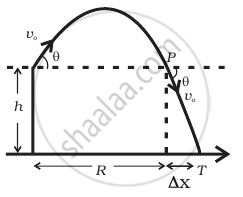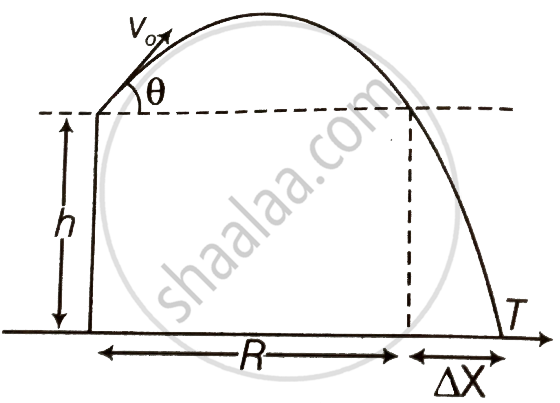Advertisements
Advertisements
Question
A gun can fire shells with maximum speed v0 and the maximum horizontal range that can be achieved is R = `v_0^2/g`. If a target farther away by distance ∆x (beyond R) has to be hit with the same gun (Figure), show that it could be achieved by raising the gun to a height at least `h = Δx[ 1 + (Δx)/R]`

Solution
This problem can be approached in two different ways:

- Referring to the diagram, target T is at a horizontal distance x = R + Δx and between the point of projection y = – h.
- From point P in the diagram projection at speed v0 at an angle θ below horizontal with height h and horizontal range ΔxA)
Applying method (i)
Maximum horizontal range, `R = v_0^2/g`, for θ = 45° ......(i)
Let the gun be raised through a height h from the ground so that it can hit the target. Let vertically downward direction is taken as positive
The horizontal component of initial velocity = v0 cos θ
The vertical component of initial velocity = – v0 sin θ
Taking motion in vertical direction, `h = (- v_0 sin theta) t + 1/2 "gt"^2` ......(ii)
Taking motion in the horizontal direction, `(R + Δx) = v_0 cos θ xx t`
⇒ `t = (R + Δx)/(v_0 cos θ)` ......(iii)
Substituting the value of t in equation (ii), we get
`h = (- v_0 sin θ) xx ((R + Δx)/(v_0 cos θ)) + 1/2 g ((R + Δx)/(v_0 cos θ))^2`
`h = - (R + Δx) tan θ + 1/2 g (R + Δx)^2/(v_0^2 cos^2 θ)`
As angle of projection is θ = 45°, therefore
`h = - (R + Δx) + tan 45° + 1/2 g (R + Δx)^2/(v_0^2 cos^2 45^circ)`
`h = - (R + Δx) xx 1 + 1/2 g (R + Δx)^2/(v_0^2 (1/2))` ......`(∵ tan 45^circ = 1 and cos 45^circ = 1/sqrt(2))`
`h = - (R + Δx) + (R + Δx)^2/R` ......[Using equation (i), R = `"v"_0^2`/g]
= `- (R + Δx) + 1/R (R^2 + Δx^2 + 2RΔx)`
= `- R - Δx + (R + (Δx^2)/R + 2Δx)`
= `Δx + (Δx^2)/R`
`h = Δx(1 + (Δx)/R)`
Hence proved.
APPEARS IN
RELATED QUESTIONS
A car starts from rest and accelerates at 5 m/s2. At t = 4 s, a ball is dropped out of a window by a person sitting in the car. What is the velocity and acceleration of the ball at t = 6 s? (Take g = 10 m/s2)
A ball is thrown from a roof top at an angle of 45° above the horizontal. It hits the ground a few seconds later. At what point during its motion, does the ball have
- greatest speed.
- smallest speed.
- greatest acceleration?
Explain
A boy travelling in an open car moving on a levelled road with constant speed tosses a ball vertically up in the air and catches it back. Sketch the motion of the ball as observed by a boy standing on the footpath. Give explanation to support your diagram.
A cricket fielder can throw the cricket ball with a speed vo. If he throws the ball while running with speed u at an angle θ to the horizontal, find
- the effective angle to the horizontal at which the ball is projected in air as seen by a spectator.
- what will be time of flight?
- what is the distance (horizontal range) from the point of projection at which the ball will land?
- find θ at which he should throw the ball that would maximise the horizontal range as found in (iii).
- how does θ for maximum range change if u > vo, u = vo, u < vo?
- how does θ in (v) compare with that for u = 0 (i.e.45)?
A football is kicked into the air vertically upwards. What is its velocity at the highest point?
A body is thrown from a point with speed 50 m/s at an angle 37° with horizontal. When it has moved a horizontal distance of 80 m then its distance from point of projection is ______.
A body starts from rest with constant acceleration a, its velocity after n second is v. The displacement of body in last two seconds is ______.
A circular disc of radius r = 5m is rotating in horizontal plane about y-axis. Y-axis is vertical axis passing through the centre of disc and x-z is the horizontal plane at ground. The height of disc above ground is h = 5 m. Small particles are ejecting from disc in horizontal direction with speed 12 m/s from the circumference of disc then the distance of these particles from origin when they hits the x-z plane is:
Two stones are projected with the same speed but making different angles with the horizontal. Their ranges are equal. If the angle of projection of one is `pi/3` and its maximum height is y1 then the maximum height of the other will be ______.
A ball is projected from the ground with a speed 15 ms-1 at an angle θ with horizontal so that its range and maximum height are equal, then tan θ will be equal to ______.
